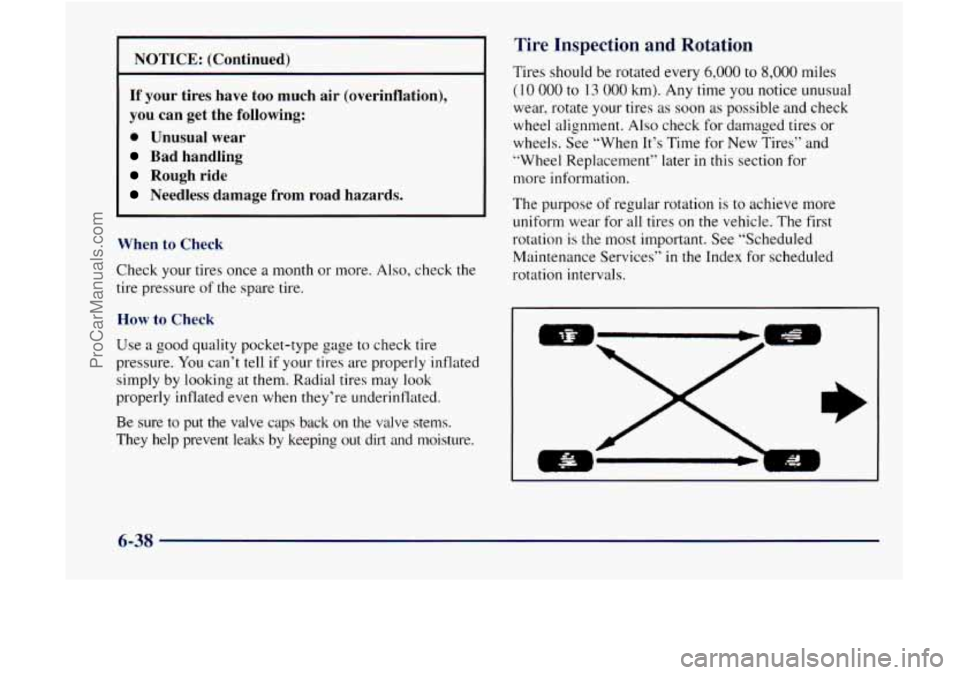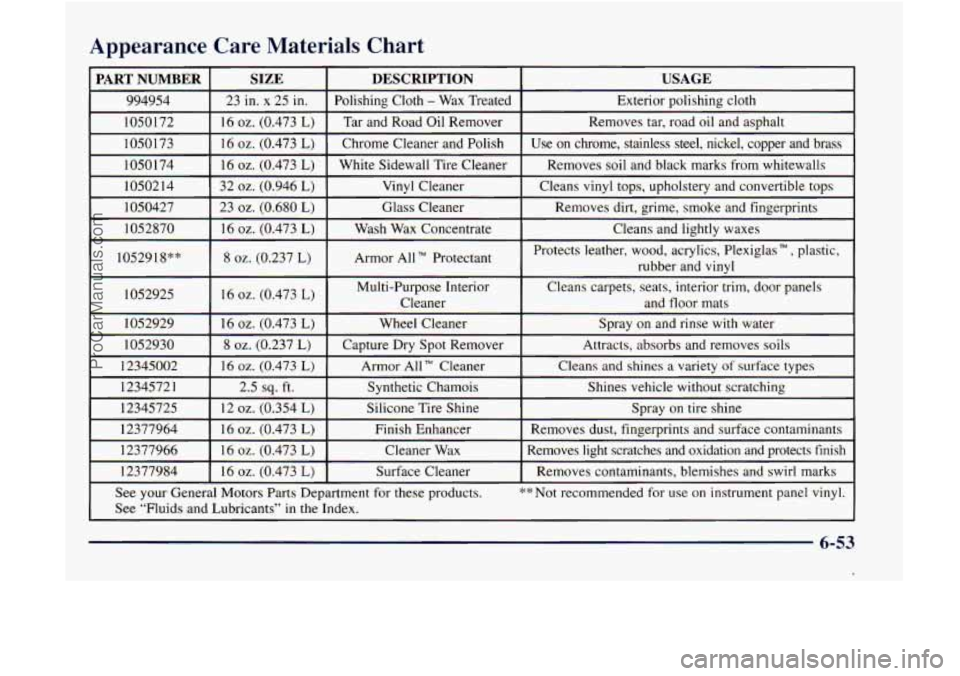1998 GMC ENVOY tire type
[x] Cancel search: tire typePage 172 of 386

0 Check your mirrors, glance over your shoulder and
start your left lane change signal before moving out
of the right lane to pass. When you are far enough
ahead of the passed vehicle to see its front
in your
inside mirror, activate your right lane change signal
and move back into the right lane. (Remember that
your right outside mirror is convex. The vehicle you
just passed may seem to be farther away from you
than
it really is.)
Try not to pass more than one vehicle at a time on
two-lane roads. Reconsider before passing the
next vehicle.
Don’t overtake a slowly moving vehicle too rapidly.
Even though the brake lamps are not flashing, it may
be slowing down or starting to turn.
0 If you’re being passed, make it easy for the
following driver to get ahead of you. Perhaps
you
can ease a little to the right.
Loss of Control
Let’s review what driving experts say about what
happens
when the three control systems (brakes, steering
and acceleration) don’t have enough friction where the
tires meet the road
to do what the driver has asked.
In any emergency, don’t give up. Keep trying
to steer
and constantly seek an escape route or area of
less danger.
Skidding
In a skid, a driver can lose control of the vehicle.
Defensive drivers avoid most skids by taking reasonable
care suited to existing conditions, and by not
“overdriving” those conditions. But skids are
always possible.
The three types
of skids correspond to your vehicle’s
three control systems.
In the braking skid, your wheels
aren‘t rolling.
In the steering or cornering skid, too
much speed or steering
in a curve causes tires to slip and
lose cornering force. And
in the acceleration skid, too
much throttle causes the driving wheels to spin.
A cornering skid and an acceleration skid are best
handled by easing your foot off the accelerator pedal.
4-13
I
ProCarManuals.com
Page 173 of 386

If your vehicle starts to slide, ease your foot off the
accelerator pedal and quickly steer the way you want the
vehicle to go.
If you start steering quickly enough, your
vehicle may straighten out. Always be ready for
a
second skid if it occurs.
Of course, traction is reduced when water, snow, ice,
gravel or other material is
on the road. For safety, you‘ll
want to slow down and adjust your driving to these
conditions.
It is important to slow down on slippery
surfxes because stopping distance will be longer and
vehicle control more limited.
While driving on a surfxe
with reduced traction, try
your best to avoid sudden steering, acceleration
or
braking (including engine braking by shifting to a lower
gear). Any sudden changes could cause the tires to slide.
You may not realize the surfdce is slippery
until your
vehicle is skidding. Learn to recognize warning
clues
-- such as enough water, ice or packed snow on
the road to make a “mirrored surface”
-- and slow
down when
you have any doubt.
Remember: Any anti-lock brake system (ABS) helps
avoid only
the braking skid.
Driving Gu idelines
This multipurpose passenger vehicle is defined as a
utility vehicle in Consumer Information Regulations
issued by the National Highway Traffic Safety
Administration (NHTSA) of
the United States
Department of Transportation. Utility vehicles have
higher ground clearance and a narrower track to make
them capable of performing in a wide variety of off-road
applications. Specific design characteristics give them a
higher center of gravity than ordinary cars. An
advantage of the higher ground clearance is a better
view of the road allowing you
to anticipate problems.
They are not designed for cornering at
the same speeds
as conventional two-wheel-drive vehicles any more than
low-slung sports cars are designed to perform
satisfxtorily under off-road conditions.
If at all
possible, avoid sharp turns
or abrupt maneuvers. As with
other vehicles of this type, failure to operate this vehicle
correctly
may result in loss of control or
vehicle rollover.
4-14
ProCarManuals.com
Page 285 of 386

NOTICE: (Continued)
If your tires have too much air (overinflation),
you can get the following:
0 Unusual wear
Bad handling
Rough ride
Needless damage from road hazards.
When to Check
Check your tires once a month or more. Also, check the
tire pressure
of the spare tire.
How to Check
Use a good quality pocket-type gage to check tire
pressure. You can’t
tell if your tires are properly inflated
simply by looking at them. Radial tires may look
properly inflated even when they’re underinflated.
Be sure to put the valve caps back on the valve stems.
They help prevent leaks by keeping out dirt and moisture.
Tire Inspection and Rotation
Tires should be rotated every 6,000 to 8,000 miles
( 10 000 to 13 000 km). Any time you notice unusual
wear, rotate your tires
as soon as possible and check
wheel alignment.
Also check for damaged tires or
wheels. See “When It’s Time for New Tires” and
“Wheel Replacement” later in
this section for
more information.
The purpose of regular rotation is to achieve more
uniform wear for all tires on the vehicle. The first
rotation is the most important. See “Scheduled
Maintenance Services”
in the Index for scheduled
rotation intervals.
6-38
ProCarManuals.com
Page 287 of 386

When It’s Time for New Tires
One way to tell when it’s
time for new tires is to
check the treadwear
indicators, which will
appear when your tires have
only 1/16 inch (1.6 mm) or
less
of tread remaining.
You need a new tire if any of the following statements
are true:
0 You can see the indicators at three or more places
around the tire.
You can see cord or fabric showing through the
tire’s rubber.
The tread or sidewall is cracked, cut or snagged deep
enough to show cord or fabric.
0 The tire has a bump, bulge or split.
The tire has a puncture, cut or other damage that
can’t be repaired well because of the size or location
of the damage.
Buying New Tires
To find out what kind and size of tires you need, look at
the Certificationmire label.
The tires installed
on your vehicle when it was new had
a Tire Performance Criteria Specification (TPC Spec)
number on each tire’s sidewall. When
you get new tires,
get ones with that same TPC Spec number. That way
your vehicle will continue to have tires that are designed
to give proper endurance, handling, speed rating,
traction, ride and other things during normal service
on
your vehicle. If your tires have an all-season tread
design, the TPC number will be followed by an
“MS”
(for mud and snow).
If you ever replace your tires with those not having a
TPC Spec number, make sure they are the same size,
load range, speed rating and construction type (bias,
bias-belted or radial)
as your original tires.
6-40
ProCarManuals.com
Page 288 of 386

I Uniform Tire Quality Grading
Mixing tires could cause you to lose control while
driving.
If you mix tires of different sizes or types
(radial and bias-belted tires), the vehicle may not
handle properly, and you could have a crash.
Using tires of different sizes may also cause
damage to your vehicle. Be sure to use the same
size and type tires on all wheels.
If you use bias-ply tires on your vehicle, the
wheel rim flanges could develop cracks after
many miles of driving.
A tire and/or wheel could
fail suddenly, causing a crash. Use only radial-ply
tires with the wheels on your vehicle.
The following information relates to the system
developed by the United States National Highway
Traffic Safety Administration, which grades tires by
treadwear, traction and temperature performance.
(This applies only to vehicles sold in the United States.)
The grades are molded on the sidewalls of most
passenger car tires. The Uniform Tire Quality Grading
system does not apply to deep tread, winter-type snow
tires, space-saver or temporary
use spare tires, tires with
nominal rim diameters
of 10 to 12 inches (25 to 30 cm),
or to some limited-production tires.
While the tires available on General Motors passenger
cars and light trucks may vary with respect to these
grades, they must also conform to Federal safety
requirements and additional General Motors Tire
Performance Criteria (TPC) standards.
6-41
ProCarManuals.com
Page 291 of 386

NOTICE:
The wrong wheel can also cause problems with
bearing life, brake cooling, speedometer or
odometer calibration, headlamp aim, bumper
height, vehicle ground clearance and tire
clearance to the body and chassis.
See “Changing a Flat Tire” in the Index for
more information.
Used Replacement Wheels
I
Putting a used wheel on your vehicle is
dangerous. You can’t know how it’s been used or
how far it’s been driven. It could fail suddenly
and cause an accident.
If you have to replace a
wheel, use a new GM original equipment wheel.
Tire Chains
NOTICE:
Don’t use tire chains. They can damage your
vehicle because there’s not enough clearance.
Use another type of traction device only if its
manufacturer recommends it for use on your
vehicle and tire size combination and road
conditions. Follow that manufacturer’s
instructions.
To help avoid damage to your
vehicle, drive slowly, readjust
or remove the
device
if it’s contacting your vehicle, and don’t
spin your wheels.
If you do find traction devices that will fit, install
them on the rear tires.
6-44
ProCarManuals.com
Page 300 of 386

Appearance Care Materials Chart
PART NUMBER USAGE DESCRIPTION SIZE
994954 Exterior polishing cloth
Polishing Cloth - Wax
Treated
23 in. x 25 in.
1050172
Cleans
and lightly waxes Wash
Wax Concentrate
16 oz. (0.473 L) 1052870 Removes dirt,
grime, smoke
and fingerprints
Glass Cleaner
23 oz. (0.680 L) 1050427 Cleans
vinyl tops, upholstery and convertible tops
Vinyl
Cleaner
32
oz. (0.946 L) 1050214 Removes
soil and black marks from whitewalls
White Sidewall Tire Cleaner
16
oz. (0.473 L) 1050174 Use on chrome, stainless steel, nickel, copper and brass
Chrome
Cleaner and Polish
16 oz. (0.473 L) 1050173 Removes
tar, road
oil and asphalt
Tar and Road Oil Remover
16 oz. (0.473 L)
- ~~
1052918** Armor All TM Protectant 8 oz. (0.237 L) Protects leather, wood, acrylics, Plexiglas TM, plastic,
rubber and
vinyl
1052925
Attracts, absorbs and removes
soils Capture Dry Spot Remover 8 oz. (0.237 L) 1052930 Spray
on and rinse
with water
Wheel Cleaner
16 oz. (0.473 L) 1052929 16
oz. (0.473 L) Multi-Purpose
Interior
Cleans carpets, seats, interior trim, door panels
Cleaner and floor mats
12345002
16 oz. (0.473 L)
See your General Motors Parts Department for these products. **Not recommended for use on instrument panel vinyl.
Removes contaminants, blemishes and swirl marks
Surface Cleaner
16 oz. (0.473 L) 12377984 Removes light scratches and oxidation and protects finish
Cleaner
Wax 16
oz. (0.473 L) 12377966 Removes dust, fingerprints
and surface contaminants
Finish Enhancer
16
oz. (0.473 L) 12377964 Spray
on tire shine
Silicone Tire Shine
12
oz. (0.354 L) 12345725 Shines vehicle
without scratching
Synthetic Chamois
2.5
sq. ft.
1234572 1
Cleans and shines a variety of surface types
Armor All Cleaner
See “Fluids and Lubricants” in the Index.
--
6-53
ProCarManuals.com
Page 307 of 386

Replacement Bulbs
Lamps
Halogen Headlamps, Composite High Beam
Tail and Stoplamps
Front Sidemarker Lamps
Front Turn Signal Lamps
Turn Signal Lamps
Quantity Number
2 9005 HB3
4 3057
2 194 NA
2 3 157
2 3157 NA
Capacities and Specifications
Type .................................... V6
Firing Order ...................... 1-6-5-4-3-2
Horsepower
................... 190 at 4,400 rpm
Thermostat Specification ........... 195°F (91 “C)
Spark
Plug Gap .......... 0.045 inches (0.114 cm)
Engine Description
............ “VORTEC”
4300
VINCode
.................................W
Wheels and Tires
Wheel Nut Torque ........... 100 lb-ft (140 N-m)
Tire Pressure ...... See the CertificatiodTire label.
See “Loading Your Vehicle” in
the Index.
6-60
ProCarManuals.com